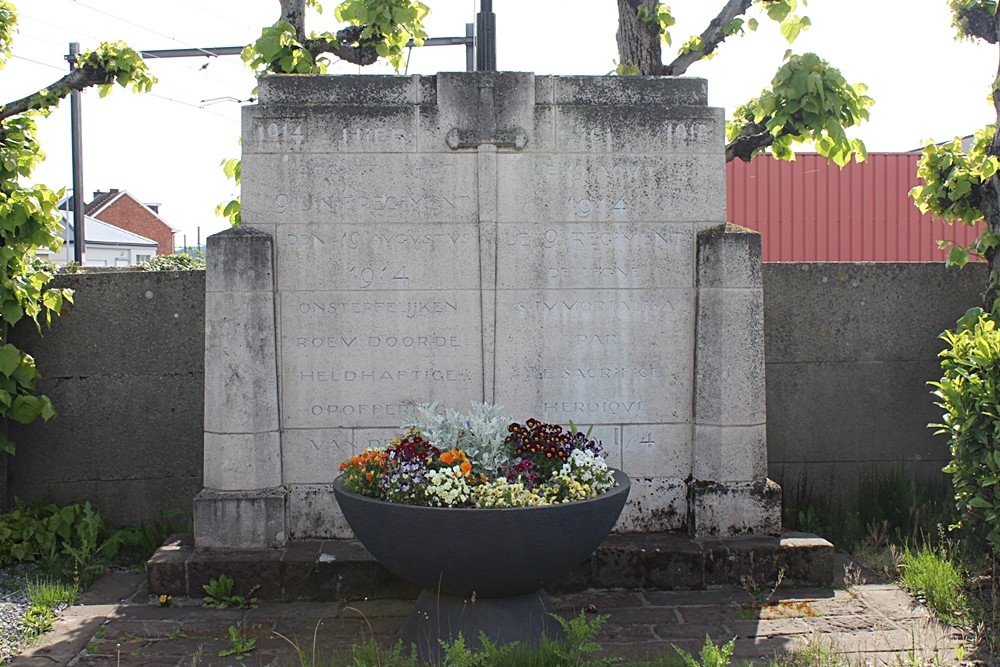Memorial 9th Line Regiment Aarschot
This memorial commemorates the heroic resistance of the Belgian 9th Line Regiment in the morning of August 19, 1914 against a German force majeure.
The facts
On August 17, 1914, the Germans broke through the Getelinie and ordered King Albert to withdraw the Belgian army to the fortress of Antwerp. On Tuesday, August 18, a rearguard of the Belgian army was placed in a semicircle around Aarschot to cover this retreat. To counteract a German attack north of the Demer, the 9th Line Regiment guarded the Aarschot - Herselt road and the railway to Antwerp. Captain Gilson and his troops from the 4th Company of the 1st Battalion organized a defense here with barricades, marksmen's pits, sandbags and barricades. Two machine guns were positioned to the left and right of the road.
In the early morning, around 5 am, a German reconnaissance group approached along the Herseltsesteenweg, followed by infantry. The Belgians let the German troops approach up to 100 meters and sowed death and destruction in the German ranks. German attacks were repelled several times. The Germans tried unsuccessfully to install machine gun posts. But the tide turned around 6:30 am. Protected by artillery, German troops encircled the fields. Gilson sent a cyclist for reinforcements, but the auxiliaries did not cross the open terrain. When the main force of the Belgian army had safely passed Kortrijk-Dutsel, the Belgian staff sent the order to withdraw. The runners did not reach Gilson and they and his men made an extreme effort to protect the city and the retreating troops. But the German supremacy was too great. At 7.45 am the captain ordered the departure. The bilan was heavy. The Belgians counted 120 dead, 600 wounded and 355 prisoners of war. Gilson was wounded in the face, but escaped safely. The Germans killed 70 people. Later, Captain Gilson wrote in his journal, "All, I repeat, all have behaved like heroes."
About the monument
During the interbellum period, on August 27, 1929, a monument was erected to commemorate these facts. Nowadays, the place where the battle was delivered is a typical, busy Flemish track with ribbon development and shops. The memorial stands to the side of the road in a spot of hedges and lime green. The Belgian flag hangs on a cast iron pole. The monument looks strict. The raw white French stone quickly pollutes here. The letters were colored silver. The sword of resilience is also a cross. At the very bottom of the text, we consider the words: "heroic sacrifice".
Do you have more information about this location? Inform us!
Source
- Text: Jan Rymenams
- Photos: Jan Rymenams
Nearby
Museum
- Stedelijk Museum, Room "War and destruction" Aarschot - Aarschot
- Allied Forces Museum Herselt - Herselt
- House of the Franco-Belgian Resistance - Tielt-Winge
Point of interest
- Peace Carillon Aarschot - Aarschot
- Glass Window Church Of Our Lady Aarschot - Aarschot
- Grote Markt Aarschot - Aarschot
Monument
- War Memorial Aarschot Cemetery - Aarschot
- OSB House Uytterhoeven Aarschot - Aarschot
- Memorial Stone Pieter-Jozef Dergent Aarschot - Aarschot
Cemetery
- Belgian War Graves Aarschot - Aarschot
- Belgian Graves Veterans Aarschot - Aarschot
- Belgian War Grave Langdorp - Langdorp (Aarschot)




